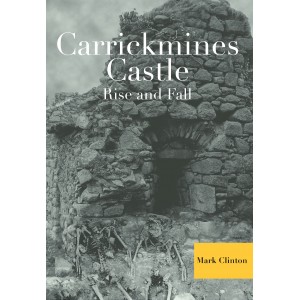Rise and Fall.
The Walshes were rooted in south County Dublin from the late fourteenth century. By the early 1600s members of the family had become actors in the theatre of war across Europe. These were times of almost endless turmoil. A constant stream of predicaments affected the lives of kings and queens, bishops and lords, men and women across the Continent.
Theobald Walsh of Carrickmines had not intended to defend his castle. The commander of the besieging forces, Sir Simon Harcourt, had not planned to attack it. Yet in March 1642 the castle was destroyed and hundreds of its occupants massacred. How did this come to pass?
Carrickmines had a simple beginning as an isolated habitation in a relatively fertile river valley. Once the settlement found itself on an emerging frontier in the thirteenth and fourteenth centuries, its character, and the lifestyle of its occupants, fundamentally changed.
Over five centuries Carrickmines would evolve from an open settlement to a defended farmstead, a fortified border outpost and a wealthy manorial centre. The Walsh family were established by the late fourteenth century. Their holdings would expand to Shanganagh, Kilgobbin and Balally in south County Dublin, and Old Court and Killincarrig in County Wicklow.
In the early seventeenth century Theobald Walsh, his father and other relatives soldiered on the Continent. The Walshes, like many other families from Ireland, were drawn by the opportunities available in the service of the Habsburg Empire. It was their misfortune that the wars would arrive at their own door. Sir Simon Harcourt, the besieger, was a veteran of the wars in Germany, Holland and Scotland, serving in the armies of both England and the embryonic Dutch state. His wife and confidante, Lady Anne, awaited his return in Oxfordshire. After two eventful days in March 1642, however, nothing would ever be the same again.
Contents
THE EARLY HISTORICAL BACKGROUND
Viking/Scandinavian settlement — The Angevin intervention
PART 1: CARRICKMINES: EARLY TENURES AND TENANTS
The Butlers of south Dublin and north Wicklow — Edward Bruce — Aunger Lissebon — Church property — Roger FitzDavid — Maurice Howel — Trade and productivity in south Dublin — The Black Death — The Rokeby line — Janico Dartasso — The Walshes of Carrickmines — Henry Walsh of Carrickmines — The second Henry Walsh
PART 2: THE SHIFTING SANDS OF THE SIXTEENTH CENTURY
The Great Earl — The Pale — Garret Óg Fitzgerald — The insurrection of 1534 — Realignments — The Walshes of Three Castles — A new order — The Walshes of Shanganagh — The Walshes of Balally — Munster — Leinster — The Second Desmond Rebellion — The Walshes of Kilgobbin — The North — The Walshes of Killincarrig — Feagh Mac Hugh O’Byrne — The aftermath
PART 3: THEOBALD WALSH: A TIME OF PEACE, POLITICS AND FOREIGN ADVENTURES
After-effects of the Treaty of Mellifont — The parliament of 1613 — Crisis of consciences — Richard Walsh, soldier of fortune — The Battle of Lützen — Theobald Walsh — Confessional contradictions — The great assembly — The Walsh cadet houses — Thomas Wentworth, earl of Strafford — Lord deputy of Ireland — The parliament of 1634 — Church reform — The threat of confiscation — Life at Carrickmines — The parliament of 1640 — Two parliaments in England — The drift towards conflict — The conflict and Carrickmines — The level of participation by Theobald Walsh — The Walshes of Wicklow — The local theatre — Carrickmines Castle
PART 4: SIR SIMON HARCOURT AND THE FALL OF CARRICKMINES CASTLE
Family background — The Palatinate — The Low Countries — The Spanish Siege of Breda — The Siege of Oldenzaal — The Siege of Groll (Groenlo) — The Siege of ’s-Hertogenbosch (Bois-le-Duc) — The capture of Venlo, Strale and Roermond — The Siege of Maastricht — Limbourg, Orsoy and Rheinberg — The Siege of Tienen (Tirlemont) — Schenkenschans — The Dutch Siege of Breda — The Battle of Kallo — Scotland — The campaign — Interlude — The second campaign — Final campaigns in the Netherlands — Chester — Ireland — Swords — Wicklow — Clontarf — Santry and Finglas — Munster — South County Dublin and County Kildare — Rathcoole, Saggart and Artane — The Battle of Dean’s Grange — The Battle of Kilsallaghan Castle — The relief of Drogheda and its aftermath — County Kildare — Carrickmines Castle
| Details | |
| Author | Mark Clinton |
| Publisher | Wordwell Ltd |
| Publication Data | October. 2019 |
Carrickmines Castle
- ISBN: 978-1-9164922-7-1
- Author(s): Mark Clinton
- Availability: In Stock
-
€30.00

